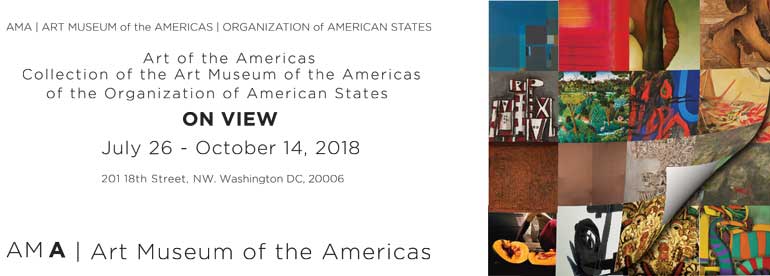Art of the Americas: Collection of the Art Museum of the Americas of the Organization of American States available for purchase.
$75 softcover
$130 limited edition hardcover
Preview online
Organization of American States
Secretariat for Hemispheric Affairs
AMA | Art Museum of the Americas
201 18th Street NW
Washington DC 20006 Art of the Americas: Collection of the Art Museum of the Americas of the Organization of American States
Organization of American States | Secretariat for Hemispheric Affairs
AMA | Art Museum of the Americas | 201 18th Street NW | Washington DC 20006
On view August 17, 2017-October 28, 2018
Reception: Thursday, July 26, 2018 6-8pm
Hours: Tuesday-Sunday 10am-5pm
The OAS AMA | Art Museum of the Americas announces the second in a series of exhibitions accompanying Art of the Americas: Collection of the Art Museum of the Americas of the Organization of American States, curated by Adriana Ospina. Initiated five years ago, the project aims to rethink the study of the historical and cultural legacy of the AMA | Art Museum of the Americas of the Organization of American States (OAS), beginning with a comprehensive catalog of the permanent collection, made publicly available in 2017.
The Art of the Americas catalog highlights key pieces of the OAS AMA art collection, representing fundamental artistic trends that have developed in Latin America, including new figuration, geometric and lyrical abstraction, conceptual art, optical and kinetic art. Artists such as Cundo Bermúdez, Fernando de Szyszlo, Agustín Fernández, José Luís Cuevas, Alejandro Obregón, Raquél Forner, Rodolfo Abularach, Alfredo Da Silva, Ernesto Deira, and Jorge de la Vega had their first solo exhibitions in the United States in the Gallery of the Pan American Union, now the OAS. The art program outgrew its space, moving into the present-day AMA in 1976. The museum has provided valuable support throughout the years in the expansion of the academic field of modern and contemporary art of Latin America and the Caribbean in the United States. Today, AMA continues and expands this rich cultural trajectory with dynamic exhibitions and educational programs highlighting the art of all the countries of the Americas. AMA’s engagement of museums outside of the U.S. strengthens ties among all OAS member countries. Drawn from Art of the Americas, this exhibition features a new selection of works, assembled with the aim of juxtaposing various facets of AMA’s collection. The resulting exhibition offers a twist on more usual selections, emphasizing a wider range of the collecting practices of AMA’s founding Director José Gómez Sicre, giving a special place to abstract practices developed in Latin America after World War II, specially “gestural, lyrical, calligraphic, and informalist.” In the last few years, AMA has used its first floor galleries to showcase geometric abstraction, while representing other movements on the second floor. Here, AMA flips this this order to give light at other abstract expressions. As scholars Mariola Alvarez and Ana Franco write in their upcoming publication New Geographies of Abstract Art in Postwar Latin America, it is time to “demonstrate the messy and much diverse history of abstract art especially in contrast to the increasingly pervasive presence of geometric abstraction as the face of Latin American art of the postwar years.”
Besides the juxtaposition between modes of abstraction, this exhibition also features Gómez Sicre’s attention to modernist primitivism in the work of Central American and Caribbean artists, as well as the role of the figure in Latin America.
For the Art of the Americas catalog,we invited a select group of curators and scholars who have had close ties with the museum and, above all else, profound knowledge of the collection. Some of them have conducted research in our archives, others have curated AMA exhibitions, and a few are former museum employees. Their perspectives on the steadily growing field of Latin American and Caribbean art are vital to the study and understanding of the collection in a variety of contexts. This exhibition is an effort to bring the content of the book to three-dimensional life, showing AMA’s collecting practices from the time of José Gómez Sicre to today. It is about the canon of Latin American and Caribbean art that the OAS and AMA has been involved with since the 1940s.
The AMA serves as the principal instrument of cultural diplomacy of the OAS. AMA’s mission is founded on the notion that the arts are transformative for individuals and communities. This guiding principle promotes the core values of the OAS by providing a space for cultural expression, creativity, innovation, dialog, and learning, while highlighting themes such as democracy, development, human rights, justice, freedom of expression, and innovation. AMA’s work draws on contemporary art to showcase a constructive vision of the future of the Americas via local and hemispheric cultural exchange.
We would like to thank our selection and research team: Felix Ángel, Alejandro Anreus, Alessandro Armato, Cecilia Belej, Carol Damian, Ana Franco, María Gaztambide, Michele Greet, Olga Herrera, Maria Leyva, Abigail McEwen, Nadia Moreno, and Mark White. We also wish to thank our publishing, design, and photography teams: Aram Asarian, Jill Bernstein, Jennifer Cardiff, Rafa Cruz, Catalina Echaurren, and Camila Matta.
Art of the Americas: Collection of the Art Museum of the Americas of the Organization of American States and this exhibition aresponsored by the Friends of the Art Museum of the Americas
Accessibility: AMA’s first floor is wheelchair accessible by appointment, with a ramp that can be installed at the back entrance to the museum. There is a gravel pathway leading to the back entrance. There is one half-step leading from the first room into the first-floor galleries. There is a flight of winding stairs leading to the museum’s second floor. Restrooms are located on the second floor. For more information on accessibility, or to make an appointment to visit, please contact 202 370 0147 or artmus@oas.org


